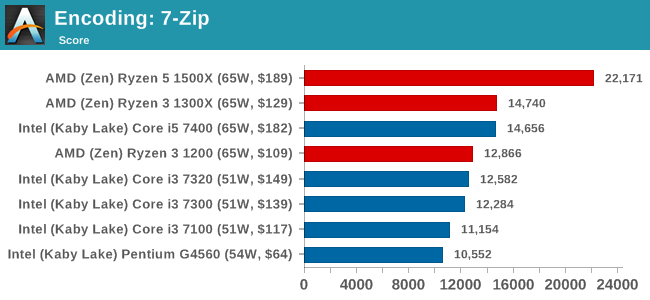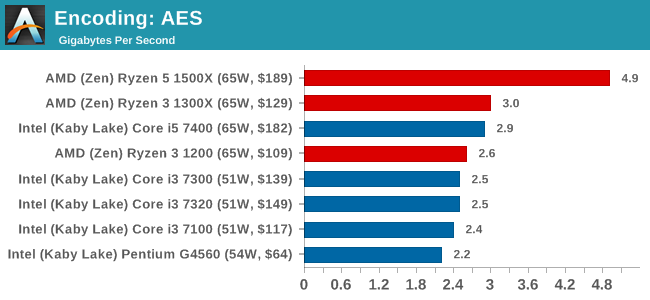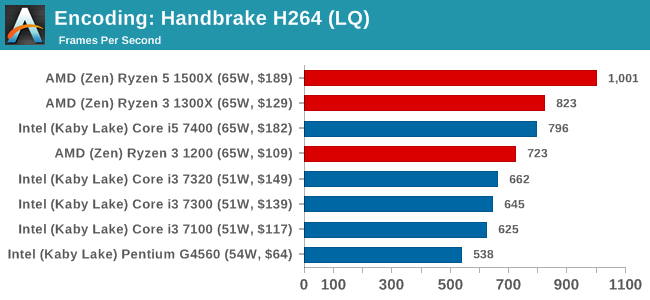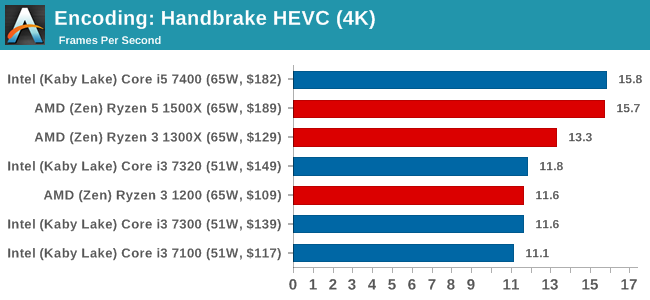The AMD Ryzen 3 1300X and Ryzen 3 1200 CPU Review: Zen on a Budget
by Ian Cutress on July 27, 2017 9:30 AM EST- Posted in
- CPUs
- AMD
- Zen
- Ryzen
- Ryzen 3
- Ryzen 3 1300X
- Ryzen 3 1200
Benchmarking Performance: CPU Encoding Tests
One of the interesting elements on modern processors is encoding performance. This includes encryption/decryption, as well as video transcoding from one video format to another. In the encrypt/decrypt scenario, this remains pertinent to on-the-fly encryption of sensitive data - a process by which more modern devices are leaning to for software security. Video transcoding as a tool to adjust the quality, file size and resolution of a video file has boomed in recent years, such as providing the optimum video for devices before consumption, or for game streamers who are wanting to upload the output from their video camera in real-time. As we move into live 3D video, this task will only get more strenuous, and it turns out that the performance of certain algorithms is a function of the input/output of the content.
All of our benchmark results can also be found in our benchmark engine, Bench.
7-Zip 9.2: link
One of the freeware compression tools that offers good scaling performance between processors is 7-Zip. It runs under an open-source licence, is fast, and easy to use tool for power users. We run the benchmark mode via the command line for four loops and take the output score.

WinRAR 5.40: link
For the 2017 test suite, we move to the latest version of WinRAR in our compression test. WinRAR in some quarters is more user-friendly that 7-Zip, hence its inclusion. Rather than use a benchmark mode as we did with 7-Zip, here we take a set of files representative of a generic stack (33 video files in 1.37 GB, 2834 smaller website files in 370 folders in 150 MB) of compressible and incompressible formats. The results shown are the time taken to encode the file. Due to DRAM caching, we run the test 10 times and take the average of the last five runs when the benchmark is in a steady state.

AES Encoding
Algorithms using AES coding have spread far and wide as a ubiquitous tool for encryption. Again, this is another CPU limited test, and modern CPUs have special AES pathways to accelerate their performance. We often see scaling in both frequency and cores with this benchmark. We use the latest version of TrueCrypt and run its benchmark mode over 1GB of in-DRAM data. Results shown are the GB/s average of encryption and decryption.

HandBrake v1.0.2 H264 and HEVC: link
As mentioned above, video transcoding (both encode and decode) is a hot topic in performance metrics as more and more content is being created. First consideration is the standard in which the video is encoded, which can be lossless or lossy, trade performance for file-size, trade quality for file-size, or all of the above can increase encoding rates to help accelerate decoding rates. Alongside Google's favorite codec, VP9, there are two others that are taking hold: H264, the older codec, is practically everywhere and is designed to be optimized for 1080p video, and HEVC (or H265) that is aimed to provide the same quality as H264 but at a lower file-size (or better quality for the same size). HEVC is important as 4K is streamed over the air, meaning less bits need to be transferred for the same quality content.
Handbrake is a favored tool for transcoding, and so our test regime takes care of three areas.
Low Quality/Resolution H264: He we transcode a 640x266 H264 rip of a 2 hour film, and change the encoding from Main profile to High profile, using the very-fast preset.

High Quality/Resolution H264: A similar test, but this time we take a ten-minute double 4K (3840x4320) file running at 60 Hz and transcode from Main to High, using the very-fast preset.

HEVC Test: Using the same video in HQ, we change the resolution and codec of the original video from 4K60 in H264 into 4K60 HEVC.











140 Comments
View All Comments
Ian Cutress - Thursday, July 27, 2017 - link
lol yup, just saw it. Should be 889, not 89.T1beriu - Thursday, July 27, 2017 - link
Congrats on getting the review out on day one!Blender 2.78 chart has wrong result number for 1300X.
http://images.anandtech.com/graphs/graph11658/8919...
Ian Cutress - Thursday, July 27, 2017 - link
We always get CPU reviews out on day one... ;)Blender is fixed.
T1beriu - Thursday, July 27, 2017 - link
Another chart that needs a little bit of edit - "Title" at the bottom.http://images.anandtech.com/doci/11658/combined_cp...
jjj - Thursday, July 27, 2017 - link
For value,in the real world mixed or lightly threaded should have more weigh, especially in the lower end where low core count and lower clocks can be a limitation.For power, when comparing diff numbers of cores , the system power is important too- lets say you can have a dual core system at 60W vs a quad at 70W peak. Even if the dual core is more efficient, at the system level the quad wins.
nathanddrews - Thursday, July 27, 2017 - link
Performance is nice and price is good IF you have a dGPU. For entry-level gaming/HTPC builds, that Intel IGP is more valuable than most people think, especially given the amount of media decode/encode power it has. All you need is i3 and you can be watching Netflix 4K or UHD Blu-ray and then switch to playing 1080p 60fps Rocket League. You can do the latter with R3 if you buy a dGPU, but sadly there's no current way to do Netflix or UHD Blu-ray without Intel SGX.MajGenRelativity - Thursday, July 27, 2017 - link
I think that's why AMD also picked this time to release Bristol Ridgemczak - Thursday, July 27, 2017 - link
Yes, imho these cpus are only mildly interesting.In this cpu performance segment, chances are pretty high that a integrated gpu would be good enough. (Sure there's always someone who has a need for high cpu / low gpu, or low cpu / high gpu performance, but I don't think that's the norm.)
So, if a integrated gpu is good enough, with factoring in the cost of an additional gpu amd can't compete on price here. The really interesting competition from AMD in this lower end market has to come from Raven Ridge APUs.
nathanddrews - Thursday, July 27, 2017 - link
In the wise words of Peter Klavin, "Totes McGotes."T1beriu - Thursday, July 27, 2017 - link
Done! Thanks.When should I come back for the full review?